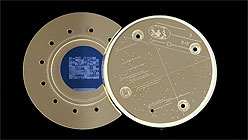A new project by artist Trevor Paglen is scheduled to launch into space on November 20, 2012 from the Baikonur Launch Complex in Kazahkstan. Paglen’s years-long project, The Last Pictures has yielded a disk encased in a protective clamshell bolted to the exterior of a satellite named Echostar XVI, which will be set on top of a Russian Proton rocket and blasted into orbit. Intricately etched onto the disk’s surface, The Last Pictures is a compilation of one hundred black and white images, each measuring about 15mm and viewable without special instruments — similar in effect to microfiche. Considered together these extensively researched images convey impressions about the end of human existence, intended to function like visual cues for another life form in the future, long after the earth has ceased to exist.
Developed in collaboration with New York-based arts presenter Creative Time, The Last Pictures cost hundreds of thousands of dollars to realize over six years of development and engaged hundreds of creative thinkers, including material scientists, aerospace engineers, philosophers, and anthropologists, among others. An extensive number of cultural specialists consulted on the project, from a curator at the Yale University Babylonian Collection to the curator of Messages in a Bottle at the Turks & Caicos National Museum in the Caribbean. The transdisciplinary nature of the project is in keeping with the artist’s work: Paglen also possesses a doctorate in geography from UC Berkeley. His work frequently interrogates space, territorial politics and the politics of orbit captioned as “experimental geography.” An upcoming performance-cum-lecture at the San Francisco Museum of Modern Art delves into the elaborate logistics and complex concerns of The Last Pictures and Trevor Paglen’s recent foray into space.

Earthrise, NASA/William Anders.
Two sets of concerns guided the project: the development of the disk as an artifact for space and the selection of the images portrayed on the disk. Paglen conducted extensive research as an artist-in-residence with engineers at Massachusetts Institute of Technology to develop an atomically stable, ultra-archival disk designed to last billions of years. Creating a method for reproducing images that would be “as archival as the sun” was essential to the development of work that functions as both a cave painting from the past and a time capsule for the future.
When asked if the disks might feature at an upcoming art fair, the artist only laughed — this was not a project designed for Miami Basel. In fact, the painstakingly produced disk will go largely unseen beyond those closest to the project. The flickering of the host satellite in orbit promises to make the work a constant contradiction: both widely visible and indiscernible, as much a figment of imagination as anything else.





